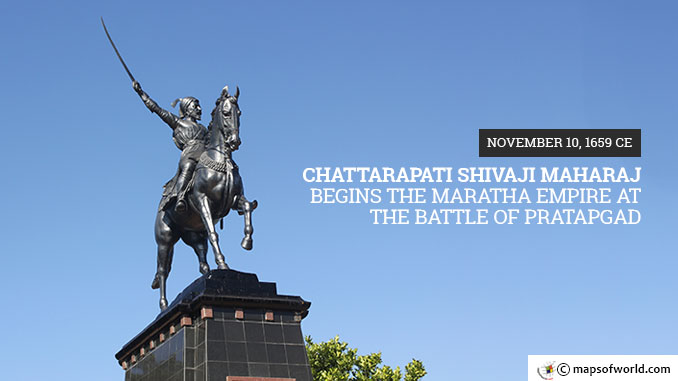The history of western India took a new turn on November 10, 1659: the Battle of Pratapgad shifted the balance of power in the region away from the Adilshahi and paved the way for Maratha rule for generations to come. As King Chattarapati Shivaji drove his troops to defeat the forces of Afzal Khan, he managed to do more than decimate the enemy army and gain new territory — he avenged the death of his brother, Sambhaji. Khan began his campaign against Shivaji early in the summer of 1659, destroying temples in order to pull the Maratha into more favorable terrain for his vast army. Knowing his superior numbers could give him victory if he only managed to set the location of the battle, Khan slowly worked his way to Pratapgad — where Shivaji and his soldiers camped in the security of the local fort — disappointed he had been unable to set the trap he hoped to. Divided into upper and lower sections, the durable stone walls gave Shivaji’s men an enviable view of the valley below. Completed just three years before, it allowed the occupying army to guard against attack from across the Nira and Koyna Rivers while fighting downhill — a major advantage for undersized armies like Shivaji’s. By the time he arrived at the foot of the fortress, Khan had 24,000 men, hundreds of camels and dozens of elephants at his disposal. Shivaji countered with an army hardly more than half the size, but a third of those were to be held in reserve in case the battle tilted too much in Khan’s favor. According to tradition, the two leaders agreed to meet unarmed to discuss a peaceful solution on November 9, 1659. (Both men hid weapons on their persons and brought bodyguards anyway.) When the moment came to greet each other, the towering Khan slid a knife from the inside of his coat and attempted to stab Shivaji in the back. Wearing armor to protect himself, the Maratha king pulled away and swiped bagh nakhi — curved blades in the palm of his hand — across his enemy’s abdomen, slashing through Khan’s organs. Khan lurched through the curtains of the tent, crying out to his followers he had been attacked. As the Adilshahi guards moved toward Shivaji, Khan was carried off by attendants in an attempt to escape before his life faded away completely. One of Shivaji’s men, Sambhaji Kavji Kondhalkar, would chase Khan’s servants and eventually decapitate the leader so his head could be sent to Shivaji’s mother as a trophy. After escaping the melee around the tent thanks to the help of his bodyguards, Shivaji raced towards the fort nursing an injury. Recognizing the agreed-upon signal, his soldiers ambushed the opposition. Catching the Adilshahi off-guard, the Maratha army took the field — and, over the next several weeks, 23 enemy forts — on the way to a famous victory. Shivaji had done more than simply defend his territory, he managed to expand his holdings and lay the foundation for the Maratha Empire, the most powerful kingdom in India from the late 1600s until the early 1800s. Also On This Day: 1293 – Raden Wijaya is crowned the first Majapahit king of Java 1775 – The United States Marine Corps is founded 1871 – Henry Morton Stanley finds Dr. David Livingstone in western Tanzania, uttering the famous line, “Dr. Livingstone, I presume?” 1951 – Coast-to-coast direct-dial telephone service begins in the United States 1958 – The Hope Diamond is donated to the Smithsonian Institution by Harry Winston
November 10 1659 CE – Chattarapati Shivaji Maharaj Begins the Maratha Empire at the Battle of Pratapgad
The history of western India took a new turn on November 10, 1659: the Battle of Pratapgad shifted the balance of power in the region away from the Adilshahi and…
1.1K
